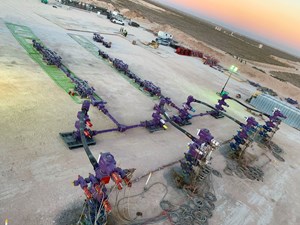Trade associations leading industry through collaboration, communication and advocacy
This year, the Energy Workforce & Technology Council celebrates its 90th anniversary as a trade association, supporting the men and women of the energy services and technology sector of the U.S. energy industry. Over the past nine decades, the organization has navigated industry challenges and changes, seamlessly adapting to meet the needs of an ever-growing and evolving industry.
History. From its foundations in 1933 as a liaison between the government and the oilfield industry in the development of a fair practice code, Energy Workforce has served as the intermediary between the energy services sector and their customers, stakeholders and government officials. The need for an open line of communication between operators, service companies and the industry regulators continues to be important today, and has implications across the entire energy value chain.
Knowledge-sharing and data. With the industry’s global reach and complex network of players, the ability to align the business trajectory of operators and suppliers is key. Collaboration with operators, who are communicating directly with service companies and equipment suppliers, is pivotal to the overall process. It allows for better alignment of business goals, leading to long-term stability in production and increased cost-effectiveness.
As the industry emerged from the 2020 pandemic, the pool of investment dollars tightened, making budgeting and spending more deliberate and strategic. Access to industry-wide market data is crucial; however, fears of disclosing proprietary information leads many companies to rely on inaccurate market information or independently develop solutions already established elsewhere. The respect and reputation that Energy Workforce has earned over its 90 years has positioned the organization to be a trusted resource navigating these complex issues.
Trade associations provide an umbrella for knowledge-sharing within anti-trust compliance, so companies can collaborate without concern of divulging confidential business practices to competitors. This collaboration enables the exchange of knowledge and best practices between E&P organizations and suppliers, which can lead to continuous improvement and a better understanding of the industry's challenges and opportunities, Fig. 1.

Working with government. Alignment and conversation are also essential to navigating government regulatory and legislative actions. The intricacies of the massive energy value chain present numerous opportunities for regulators to impact business operations, and a niche regulation impacting one portion of the sector can have a ripple effect throughout the entire system. It is important for operators and suppliers to be aware of regulatory actions impacting all aspects of the industry, and coordinate accordingly to ensure these mandates do not disrupt the industry as a whole. Additionally, effective coordination and communication between operators and their suppliers can result in opportunities to access government grants and funding programs, and strengthen calls for regulatory initiatives that improve market conditions.
Striving for better fiscal results. Often, the emphasis in supply chain is cost-savings by focusing on driving supplier prices downward. However, collaborative long-term partnerships can lead to cost-savings for both E&P companies and their suppliers. By working together, they can identify ways to improve processes, reduce waste and negotiate better pricing. This can help lower overall project costs and increase profitability, while keeping suppliers’ margins healthy and sustainable.
Building strong relationships with suppliers fosters long-term partnerships. These enduring connections create a sense of trust and commitment, leading to better project outcomes, increased reliability, and shared success.
More broadly, understanding and fostering cohesion among stakeholders within the energy industry is a challenging but important endeavor. As Energy Workforce celebrates 90 years of industry engagement, we look forward to serving and advancing the future of the industry.
- Dallas Fed: Outlook improves, even as activity little changed; break-even prices increase (April 2024)
- The last barrel (February 2024)
- Oil and gas in the Capitals (February 2024)
- What's new in production (February 2024)
- First oil (February 2024)
- E&P outside the U.S. maintains a disciplined pace (February 2024)
- Applying ultra-deep LWD resistivity technology successfully in a SAGD operation (May 2019)
- Adoption of wireless intelligent completions advances (May 2019)
- Majors double down as takeaway crunch eases (April 2019)
- What’s new in well logging and formation evaluation (April 2019)
- Qualification of a 20,000-psi subsea BOP: A collaborative approach (February 2019)
- ConocoPhillips’ Greg Leveille sees rapid trajectory of technical advancement continuing (February 2019)



